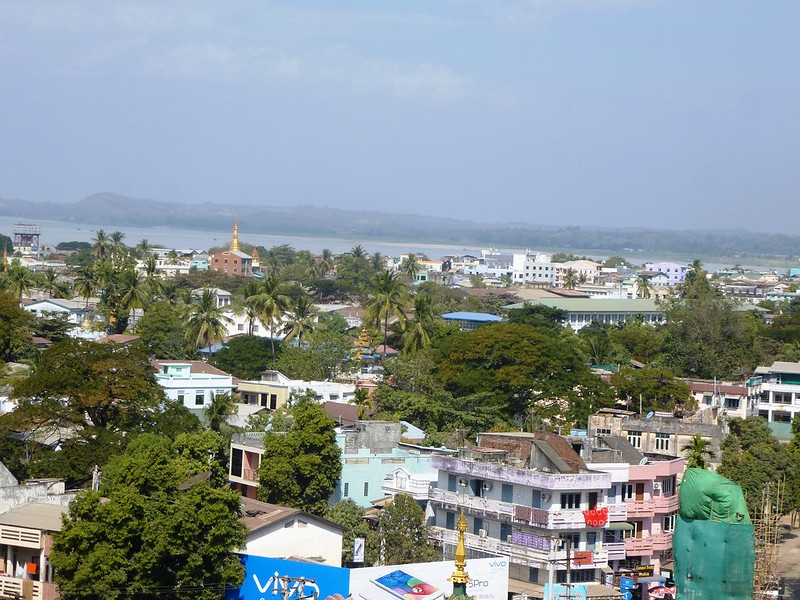If you’re wondering what to do in Pyay, there are many things you can see and do. Listed below are some of the most popular things to see and do in the town. We also included information on the Sri Ksetra World Heritage Site, Shwesandaw Paya, Akauk Taung, and the Hmawza Srikshetra Museum. All of these attractions are must-sees when visiting Pyay.
Shwesandaw Paya
The main attraction of Pyay is the Shwesandaw Paya, which is about the same size as the Shwedagon Pagoda in Yangon. This is an important pilgrimage site that is said to hold a tooth and hair of the Buddha. Another attraction in Pyay is the Thayekhittaya, a small government museum and a pilgrimage site. You can walk or cycle through the city walls and see the three pagodas along the way.
After visiting Shwesandaw Paya, you can also head to the nearby Akauk Taung, a picturesque spot on the Ayeyarwaddy River. This site has many Buddha statues carved into the cliff walls. The pagoda and monastery are located atop a hill, offering panoramic views of the city and river.
Located on a hill in the center of Pyay, the Shwesandaw Pagoda is one of the main points of interest in Pyay. It is one of the country’s most popular Buddhist pilgrimage sites. It is 88 metres high and is a traditional Burmese design. You can visit the golden zedi, which is home to four strands of Buddha’s hair.
TRAVELLING TO MYANMAR
Need a visa? Try iVisa
Sri Ksetra World Heritage Site
The UNESCO-listed Sri Ksetra World Heritage Site in Myanmar is an ancient city that was built in the shape of a circle. It spanned an area of 5.5 square miles, and its outer perimeter measured 8 miles, five furlongs. The ancient city, which was once the largest in Myanmar, is located at North Latitude 18 degrees 75 minutes and East Longitude 95 degrees 25 minutes.
The oldest remains of the Sri Ksetra World Heritage Site are the brick pagodas and temples. These structures are over 1,500 years old, and many are constructed in the vaulted arch style that was popular in Southeast Asia and Myanmar. However, heavy rains have caused many of the monuments to deteriorate rapidly. Some have cracked walls and eroded the bricks within their arches. Others have fallen to the ground and lean to one side.
In the heart of the city is the Shwesandaw Pagoda, one of the most important Buddhist pilgrimage sites in Burma. It is one meter taller than the Shwedagon Pagoda in Yangon. The Shwesandaw Pagoda also showcases the city’s retrospective glory. Another important site in Pyay is Mingyi Taung, the birthplace of the famous Pyu king Beydayi.
Akauk Taung
If you’re in Myanmar, you must visit the cliffside carvings of Akauk Taung, the country’s largest pagoda. The site is located approximately eight kilometers east of Pyay. The town’s museum features well-preserved artifacts. The town is not very large, but visitors can explore the area on foot or by motorbike. Motorbikes can be rented to travel around the monuments.
In Pyay, you can visit the ancient city states of the Pyu people. Visit the Shwemyetman Paya, which contains a huge Buddha statue in gold-plated spectacles. Many pilgrims believe that the image can cure their eye ailments. There’s also a glass case with old eyewear that was abandoned at the pagoda. You’ll want to wear a pair of binoculars to see them clearly.
You can also visit the archaeological site of Akauk Taung, located along the banks of the Ayeyarwaddy River. The site is easily accessible by motorbike or taxi from Pyay. Another option is to take a boat from Htone Bo. The journey will take approximately 30 minutes. After arriving at the site, you can go up to the pagoda, explore the surrounding forest trails, and enjoy the picturesque views.
Hmawza Srikshetra Museum
The Hmawza Srikshetera Museum in Pyay is an archaeological site and museum. The site was discovered in 1906, and the Government Archaeologists, including a French scholar of Indochina, decided to build a shelter for the stone figures. The shelter was completed in March 1915, and today, it contains an extensive collection of artifacts from Srikshetra.
The town was once known as Prome and Sri Kshetra, two ancient Pyu settlements that existed along the Irrawaddy River. It was the largest Pyu settlement, and the city walls covered an area of 1,477 hectares (47 square kilometers). Before the Angkorian Empire, Pyay was the largest Southeast Asian city before the Angkor temple complexes.
The pagoda was built in the early Thayaykhittayar Pyu Period. It is cube-shaped with a cylindrical top and has a statue of Buddha and two great disciples inside. Its stone status is inscribed with ancient Pyu letters. Although the donor of the pagoda is unknown, it is a prototype of Bagan architecture.
Sehtatgyi Buddha
A visit to the Sehtatgyi Buddha in the village of Pyay, Myanmar is not complete without visiting Shwedaung, the village closest to Pyay. The village is home to the country’s oldest monasteries, including Shwedaung, which is made of Teak wood. In this image, a young monk walks past a small Buddhist monastery with rice fields in the background.
The town of Pyay is centered on a hill, the Shwesandaw Pagoda, one of the most important Buddhist pilgrimage sites in Myanmar. The pagoda was built in 589 BC and is 90 meters high, so visitors must take an elevator up to the viewing platform to see the magnificent Sehtatgyi Buddha. You can also see the Golden Hair Relics in the nearby Shwesandaw Pagoda.
Phayagyi Pagoda
You should consider visiting Pyay’s Phayagyi Pagod – a magnificent Buddhist temple located just outside of the city. This site is located in an idyllic natural setting surrounded by lush greenery and a plethora of buddha statues. If you’re visiting Pyay with children, be sure to pack plenty of snacks and sunscreen.
Another of the things to do in Pyay is visit Shwesandaw Pagoda, the world-famous golden hair-relics monument. This Buddhist pilgrimage site is three feet taller than the Shwedagon stupa and is part of the city’s UNESCO World Heritage Site. You should visit this site early in the morning when the pilgrims are most active, as thefts have occurred near the pagoda.
After visiting Phayagyi Pagogyi, visit Akauk Taung, a scenic hillside site south of Pyay. It is home to dozens of Buddha images carved into cliff walls overlooking the Irrawaddy River. This scenic hilltop location is also known as Customs Hill. There is also a relic of Buddha’s hair here.
Tharaykhittaya Archaeological Museum
The Tharaykhittaya Archeological Museum is an interesting place to visit in Pyay, Myanmar. The town of Pyay was once known as Sri Ksetra, and the ancient name for the area was Pyay. A silver bowl that was imported from China in the 7th century, bearing the Pyu inscription on the reverse, is also on display.
The town is home to several Buddha images carved into cliff faces overlooking the Ayeyar waddy river. The statues were donated by tax collectors who assessed fees on river trade. The most recent image is dated 2001. The museum is well-located and easy to find. It is a good place to spend a few hours exploring this city.
Traveling to Pyay from the north can be a challenge, but there are some excellent travel options from here. While a new highway has made getting to Bagan more convenient, there are other nearby destinations. Mrauk U is known for its ancient sights and traditional Chin villages. Those on a budget should consider traveling to Taungup. You can also reach the town of Ngapali through Thandwe, which is a small resort town 6 km from Pyay. Lastly, you can visit the towns of Pathein, where you can buy handcrafted umbrellas.
Pyay Elephant Camp
The best way to experience an elephant safari in Myanmar is to visit the Pyay Elephant Camp. This is a remote area where the residents are mostly workers of Myanmar Timber Enterprise. While there, you’ll be able to observe the elephants in their natural habitat and learn about their daily routines. It’s important to understand that elephants don’t live on the food provided at the camp; they need to forage for food in the jungle for 3 metric tons of it a day. As such, they are very dependent on mother nature for their daily nutrition.
You’ll be treated to a welcome local drink or snack before a day of elephant riding. After your stay, you’ll be able to observe how the elephants bathe, observe the daily activities of their mahouts, and even take a ride on one of them. You’ll also get to see a skeleton of a dead elephant preserved in a bamboo house.
10 interesting facts about Pyay Myanmar
- Pyay is a city located in the Pegu Division of central Myanmar. It is also known as Prome.
- The city is an important cultural and economic center in the region, with a rich history dating back to the ancient Pyu kingdom.
- Pyay is home to several important Buddhist temples, including the Shwesandaw Pagoda, which is believed to contain a strand of the Buddha’s hair.
- The city is also home to the Pyay Technological University, which was established in 1993 and offers a range of engineering and science programs.
- The city is located on the Ayeyarwady River, which is an important transportation artery in Myanmar.
- Pyay is known for its agricultural production, including rice, wheat, beans, and various fruits and vegetables.
- The city is a hub for trade and commerce, with a large market and a number of small businesses.
- Pyay is home to several festivals and events throughout the year, including the Pyay Balloon Festival, which features hot air balloon rides and cultural performances.
- The city is located approximately three hours by car from the capital city of Yangon.
- Pyay is known for its hot and humid climate, with temperatures averaging around 30°C (86°F) throughout the year.

